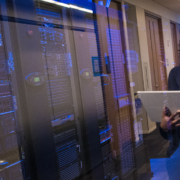Digital Transformation and Cybersecurity
Digital transformation and the associated (IT) change management have evolved from buzzwords to important drivers in companies. German SMEs are also catching up with these important developments, albeit still hesitantly. Many entrepreneurs shy away from major upheavals in their IT landscapes. Often, they are also faced with the question of how they can drive these important fields forward – without the important topic of cybersecurity falling behind?
The increasing networking of all machines, as well as business processes, means that entire IT landscapes are at risk from external influences. Therefore, in addition to a digital strategy, a security strategy based on it should also be introduced in the company. This also means that the budgets for corporate IT must be adjusted. After all, a technical upgrade without security measures in the background is on shaky ground.
Here are some important tips
Dismantle isolated solutions
IT structures are usually evolved solutions that have been expanded and supplemented whenever necessary for the respective business model. These isolated solutions are sometimes better, sometimes worse connected via different interfaces – but sometimes they exist side by side so that each branch or subsidiary has its solution. It is obvious that not only the application structure is confusing, but also the security of the systems is often rather nebulous in such a landscape. Each system must be protected separately, and if – for example when an employee leaves – the network and security plans have not been properly documented and passed on, it is also possible that important protection and security measures may not have been properly checked and adapted.
In addition to economic reasons, the security aspect should also be reason enough for most companies to dismantle these heterogeneous, poorly networked IT landscapes and replace them with an end-to-end application and network landscape. This saves costs and resources in setting up and maintaining company networks and ensures uniformly high-security standards in your company.
Do not rely on top-down communication
When describing the approach of German companies to digitization, one often encounters the terms “hesitant,” “slow” and “risk-averse.” Nevertheless, it is clear that something is happening – but also that SMEs, in particular, are having a hard time. Especially when it comes to introducing new systems, which may also entail the introduction of new processes. Especially at the management level, people are too attached to the old, which they then want to transform into the new. This does not work! Particularly because the employees are not included in the process. Because digital transformation and change management thrive on the dialog. And especially from down-top communication. Yes, you read that correctly. Your employees are the key to the success of your digital transformation process.
Therefore: Take your employees with you
This means two things: learn from your employees. The younger, tech- and IT-savvy generation, in particular, wants to, and especially can, get involved. They contribute ideas. And more importantly, they will provide and implement knowledge. At the same time, it is also important to take along those employees who are rather critical of new technology and the associated change. Take their concerns seriously and address them in your IT and security concept.
But it also means that you should invest in your employees’ knowledge of cybersecurity. Important here: all employees who work in your network and access at least one of your systems or one of your deployed applications. Because no matter how well your company is technically positioned in terms of cybersecurity, the biggest weak point in your security network is the human factor: phishing and social engineering attacks are becoming increasingly sophisticated. That’s why you should optimally prepare your employees for such an emergency through training and testing. In this way, you can proactively close gaps for attackers in the best possible way.
Be proactive
Many companies, but also private individuals, still underestimate how important it is to invest in preventive security measures. As a result, the budget for digital transformation in companies is often large, but the budget for the associated security mechanisms is incomparably smaller. This “what’s going to happen to us” mentality can quickly become very expensive. Even if it doesn’t seem like it at first: investing in security upfront is much cheaper than reacting to damage that has occurred.
Have you been hacked? That means downtime, possible data loss, but even worse: loss of reputation and, in the worst case, dwindling order numbers due to late deliveries or due to your customers’ lack of trust in you and your compliance.
You see: Action pays off. And the reaction can therefore only be the last resort.
Your benefits from a digital transformation based on Cybersecurity
Application and data security and availability
High-security standards ensure that your employees always have access to the applications they need. This is the only way to ensure that business processes run smoothly. At the same time, you protect your company’s data and that of your customers. In addition to operational processes, this is also more than necessary concerning legal regulations.
Best user experience, first-class compliance management, and cost-efficiency
Networked systems allow your employees to quickly and easily switch between applications with similar user interfaces. This saves a lot of time when learning new programs, but also in the daily workflow. At the same time, with such networking, these systems must be adequately protected so that they cannot be compromised. This sounds costly at first, but imagine the effort if you had to install and maintain security mechanisms at the same high level on every single application. This way, you make things easier for your IT, as well as for the end-user at the workstation. And you can deliver a higher security standard for a lower budget.





 HWS Gruppe
HWS Gruppe
